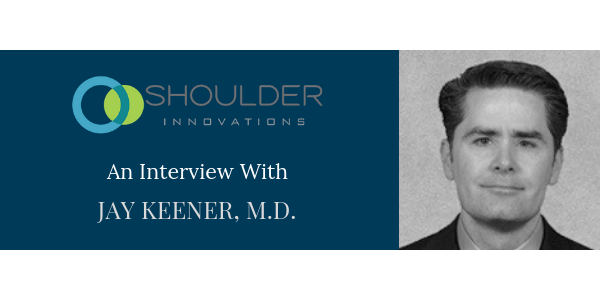We recently had the opportunity to meet with Jay Keener, M.D. specifically to talk about his background, and his experiences using the InSet™ glenoid from Shoulder Innovations.
Dr. Jay Keener is the Chief of the Shoulder and Elbow Service at Washington University in St. Louis.
David Blue: Dr. Keener, would you please share your background with us, including how you became involved in healthcare and specifically orthopedics?
Dr. Keener: I was a physical therapist for a few years and then went back to medical school to become an orthopedic surgeon.
I’m a shoulder and elbow specialist and have been in practice for 14 years now. Just exclusively manage shoulder and elbow problems.
David Blue: What was it that attracted you specifically to shoulder and elbow as a specialty?
Dr. Keener: I think shoulder and elbow are probably the more challenging joints in the body, shoulder especially.
Having done a lot of sports rehab – knees, ankles, spine, and shoulder, I just thought [shoulder] was biomechanically a very complex joint and some of the more challenging problems to treat.
So that was a natural transition into the specialty.
David Blue: How did you first learn about the InSet™ Glenoid, and the Shoulder Innovations team?
Dr. Keener: I was invited to take a look at the implant and see if I wanted to be involved in modifying the design and advancing it to the next level and helping to bring it to market.
David Blue: What was your initial impression of Shoulder Innovations and the concept of the InSet™ glenoid?
Dr. Keener: Well, my first response was skepticism because it’s radically different in its design.
However, the team that they assembled is excellent, especially the engineers involved who spearheaded the project. They have a lot of knowledge and experience with shoulder arthroplasty design.
The InSet™ glenoid concept is completely different than what we are traditionally taught for glenoid resurfacing because you’re not covering the entire glenoid with an onlay design, you’re putting a smaller device in, and the entire device is buried into the surface of the bone. It could give much better fixation biomechanically.
So I was a little surprised and skeptical at first. But looking at the data, in terms of stability, and Dr. Steve Gunther’s clinical experience with putting in an InSet™ implant for over a decade seemed to make sense from a scientific standpoint, and there was some good clinical data behind it.
David Blue: What has been your personal experience in using the InSet™ glenoid?
Dr. Keener: I think the system is awesome! It can be your everything anatomic shoulder arthroplasty system if you want it to be.
The way I use it, and for the indications that I try to tackle with this product, it has worked very well.
Specifically, in instances where I have a lot of bone deformity on the glenoid, central bone loss and there’s a limited amount of bone for fixation, this implant works really well.
David Blue: If you were sitting down with a fellow surgeon to talk to them about this technology for the very first time, what would you tell them?
Dr. Keener: I would tell them that we have an implant now that might help solve the problem of glenoid loosening that is seen at seven, eight, ten plus years later.
The data’s not there yet, but it’s a new design theory that may translate to really good outcomes down the road. Because that’s the weak link in shoulder replacement is the survivorship of a glenoid implant. So I think that we’re on to something here.
The other thing I would tell them is the next generation humeral design is going to be excellent at recreating the anatomy of the humerus while preserving bone.
I would tell them that we are in a good place now with the first-generation design, but there’s a lot of exciting advances coming both on the humeral and the glenoid side.
David Blue: Do you have any tips or pieces of advice that you would give other surgeons if they were using the system for the first time?
Dr. Keener: As far as the system goes, the concepts are easy, and the execution is easy.
I think that like with any new system, there are some subtle nuances that you’ll have to get through on your learning curve, but they’re pretty seamless, and the implant is no more difficult if not a little easier to put in.

